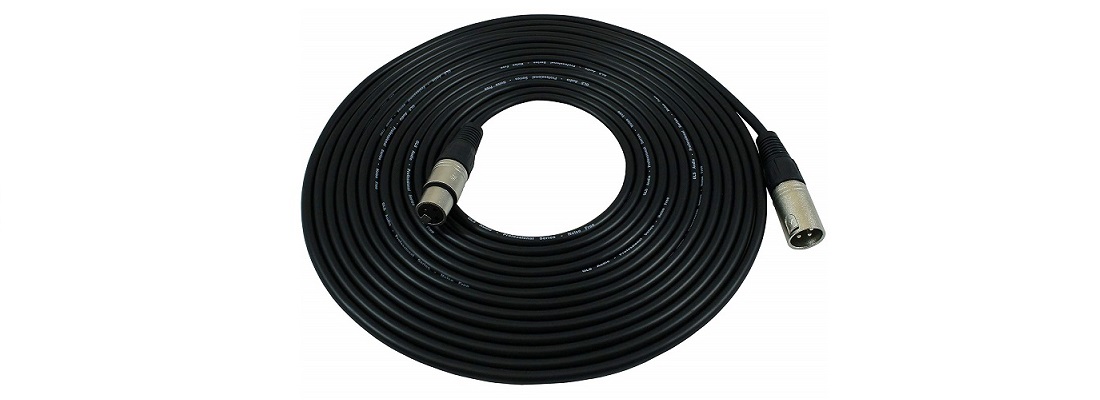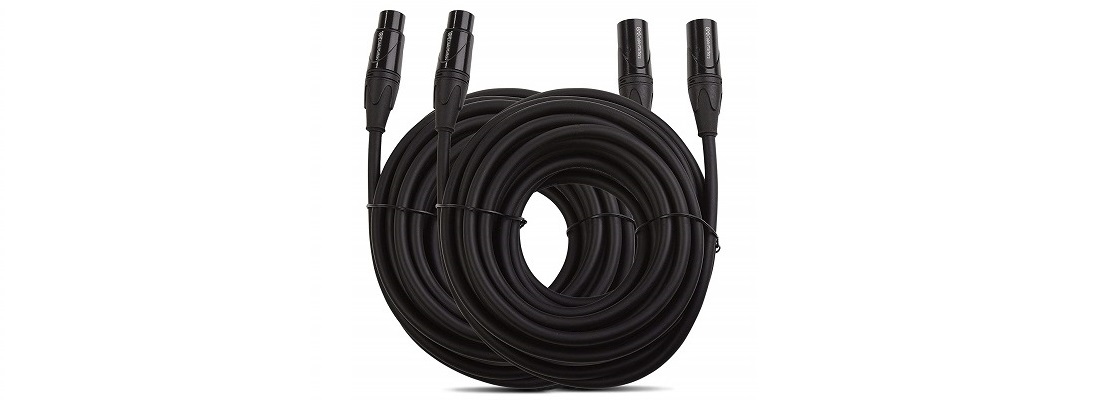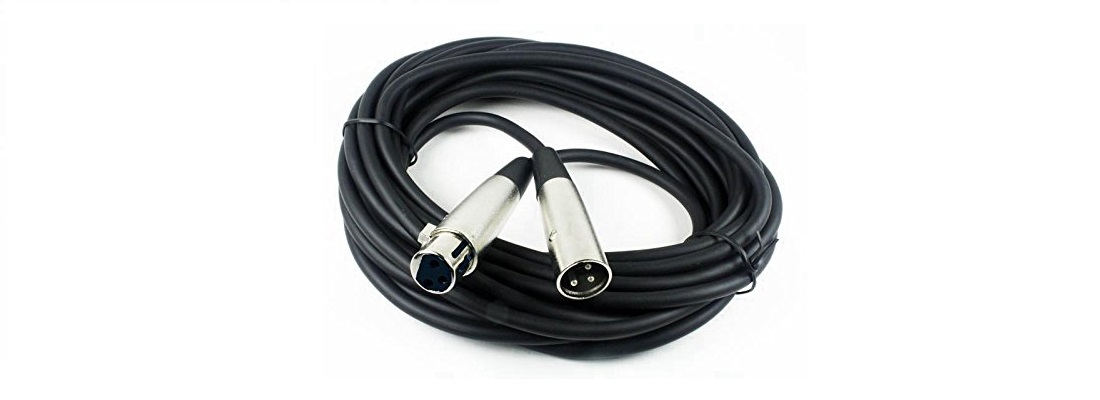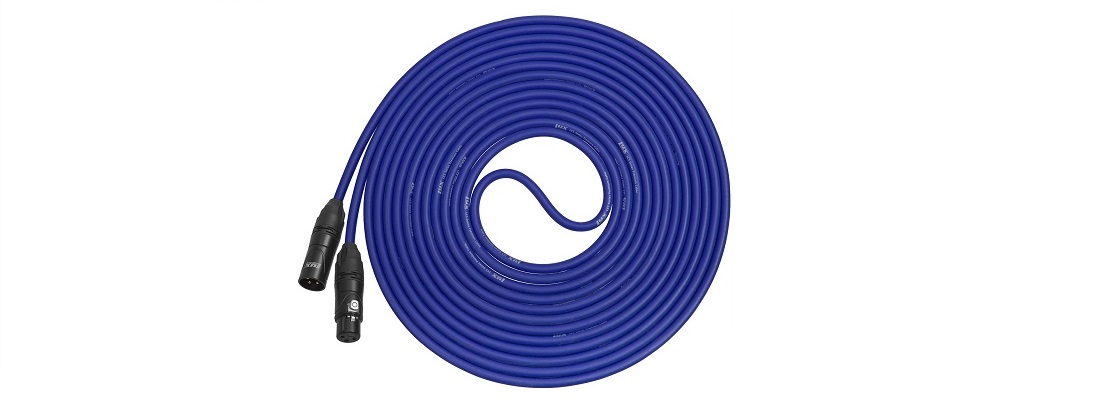Those people that deal with rental and production, or arrange corporate events can’t help but seek the best XLR cable. This product is vital for live sound and recording studio applications. Besides, it’s often used to be hooked up to the microphones in order to deliver the power from mixing boards.
Those units are indispensable when there is a long distance between the components of the acoustic system or studio equipment. They’re able to transmit the weak signals for dozens of feet and add +6 dB to the signal strength.
Note that the XLR mic cable can joint several devices in a network, but all of them are balanced in the majority of case. However, some advanced models can work with unbalanced devices. Besides, the cords have different length; so, consider the distance between sound applications and speakers, as well as possible obstacles between them, before choosing a certain model of XLR cable on Amazon.
When looking for the proper XLR audio cable, think of ways to use it first. For example, durable shielding is crucial if connecting it to live sound applications. Flexibility is also important since one should easily move a cable around the stage. High-quality cords with PVC Jacket are usually the most flexible. Keep reading to know more about these cords in order to pick the proper compatible unit.
XLR Cable Reviews
GLS Audio 25 foot Mic Cable: Best XLR Cable

If looking for the best XLR cable, pay attention to this product that is remarkable for good value for money and provides reliable connections. Its length is 25 feet that are quite enough for the majority of stages. Besides, it features great 21 gauge conductors that are made of copper. It can handle a wide load of electrical power and dispense much armoring and insulation. Moreover, it’s designed to resist heat effectively and to prevent overloading.
This unit comes with a rubber strain-relieved jacket and shield that are flexible and thick enough to use it in the home studio environment, in rehearsal, and take to a few local shows a month. It performs well without hum from any gear. The floor noise reduction is significant and the sound is completely distortion-free, without interference or scratchiness.
Pros
- Fits a wide range of applications, including recording vocals and performing live.
- Provides the enhanced tonal range and sensitivity of the signal produced.
Cons
- Too little screws require keeping an eye on them each time they’re installed.
Mogami GOLD STUDIO-15: Top-notch Flexibility and Sturdy Building

This unit is an original product from Japan and it is one of the best XLR cables despite its not impressive length (just 15 feet). It’s designed for both professional and home studios. Its main task is to nullify radio frequency and electromagnetic interferences. This product also does its job when transmitting precise audio signal with low noise. It consists of double-conductor quad wire and features a spiral shield that is made of bare copper. Its high conductivity allows saving signal integrity. Besides, it is very flexible and can be twisted in narrow hard-to-reach places.
The unit comes in black coating with gold-plated connectors that aren’t subject to corrosion. It has XLPE insulation to provide the unit’s enhanced water-tree, thermal, and flow resistance. It also helps escape short circuit and overload levels.
Pros
- It can be hooked up to a subwoofer with XLR output.
- Great for such applications such as an audio preamp and power amplifier, as well as active monitors.
Cons
- Has a small jacket that fits a small-diameter quad mic cable only.
- It’s a 16 gauge wire that means average thickness (high traffic film sets, for example, require thicker cables).
Hosa HMIC-010 REAN: Top-quality Conductors for Any Type of Mic

This XLR microphone cable features branded silver-plated connectors to transmit the signal flawlessly and to make any noise not audible. Its conductors are made of oxygen-free copper of the highest purity that increases the cable’s electrical conductivity by 1% and provides great thermal conductivity. Such conductors are also remarkable for their high corrosion resistance. They can serve up to 25 years at high temperatures (up to 302oF). Those properties allow using the cable either in studios or on the stage. Due to the good signal-to-noise ratio lets the signal power dominate noise power.
The unit will work for any microphone with an XLR connection whether it’s passive or requires phantom power. It’s also designed to connect speakers to the XLR mixer. It’s crucial to let the studio microphone warm up for 20–30 minutes before use to prevent hardware issues.
Pros
- Fits to connect a preamp to an amplifier.
- Good locking action when connecting or disconnecting.
Cons
- The cable is stiff and hard to coil.
- No long enough – just 10 feet.
AmazonBasics XLR: Good Audio Quality for Moderate Recording/Live Sound

When thinking of the best quality XLR cable, pay attention to the 10-feet AmazonBasics XLR model. It has a basic but still high-quality design and components to play live and record in the studio. It features metal housings of connectors to provide their good protection. Its spiral shielding is made of copper to keep the cable securely and decrease interferences and noises. It’s a male-to-female unit and it has a PVC jacket with 6.0 mm outer diameter.
The unit is a standard product to connect the mic to the input device that comes with phantom power. It’s light and flexible enough to be convenient in use. If it’s necessary to hook it up to a portable device, the adapter is required because those products lack XLR connectors. However, one can use the cable to connect speakers. Sometimes, it’s also possible to use this unit to hook up a speaker to a sub, but it depends on the socket required.
Pros
- This model can go from a 3-pin on a preamp to a 3-pin on a powered speaker.
- Substantial strain relief at both ends.
- Has two Velcro fasteners to keep it well-organized for storage.
Cons
- Does not click into place and needs a firm push to snap connections together.
- The insulators are not shrink-wrapped.
Cable Matters 2-Pack Microphone Cable: For Home and Professional Equipment

This microphone XLR cable is noticeable for its 25-feet length and two units in a pack. The unit is designed for professional low impedance microphones and can interconnect such audio equipment as mixers and power amplifiers. In addition, it’s good to connect two Bluetooth speakers to play simultaneously.
Besides, it features oxygen-free copper conductors to serve for many years hassle-free and provide accurate sound that is completely pure and as close as possible to the original audio (as it comes from the band or a singer). It comes with copper braiding shielding to eliminate noises effectively. Its black metal connectors are sturdy and pins are golden-plated. Certainly, they’re not so conductive as silver-plated pins but still don’t tarnish over time. The cable-protection sleeves are made of hard rubber.
Pros
- It’s compatible powered speakers with XLR connections.
- It’s great for both analog audio and AES/EBU data.
- The cord is thick and pliable enough.
Cons
- The locking tab on the female plug is plastic.
CBI MLC LowZ: Budget Cable to Deliver Clean Sound

This high-quality XLR cable is a consistent and durable 20-feet cord. It provides tight connections and responds no worse than the high-end units. It’s a good product for the small stage with the stationary microphones that are usually installed on the stand. Good feel and easy to clean. Besides, it produces a clean, clear, and crisp sound without interferences.
This model is designed for transmitting a low-impedance signal with 200-600 Ohms. It can be used with both musical instruments and microphones. Note that it cannot lock to the microphone or amp and supply phantom power to mics. However, it’s compatible with dynamic microphones. In general, it’s a great product for home music sets, but it can hardly be recommended for any serious recording or events.
Pros
- Keeps shape when wounding without need for a cable wrap.
- Works well with the portable Bluetooth speakers.
Cons
- It’s a bit thin that can reduce its lifetime (that’s why it’s not recommended for those that prefer to move around a lot).
- Comes with old-school switchcraft connectors that are not for road use.
LyxPro Balanced XLR Cable: Versatile 24 Gauge Product

This 20-feet XLR cord features the compatibility with a wide range of equipment including microphones and speakers, live concerts, and professional album recordings, as well as linking mixers. So, it fits both studio and stage. The connectors are made of high-quality OFC Copper and boast a thick 24 gauge that increases the product’s durability. It’s able to withstand the workload while traveling and playing live gigs.
The unit is not stiff at all and comes with two PVC conductors and cotton-wrap shield (98% braided) that makes background sounds not audible and enhances the ultimate sound. Besides, it becomes a good replacement for DMX lighting cables.
Pros
- Bright-blue coating enhances its visibility (no chance to lose them among other wires).
- This unit comes with golden contact points that’s why it’s sufficiently corrosion proof.
Cons
- It’s not designed to transmit high-power signals between an amp and a speaker.
Buyers Guide
XLR Cable – Clear and Full Definition
What is an XLR cable? – The time came to clarify the issue. It’s a type of cord to make connections between home or professional items of sound equipment. This accessory may be produced in male and female versions. It comes with a circular connector that includes 3–7 pins (conductors). The majority of units have three pins. The first pin is negative, the second one is positive, and the third conductor is ground.
The positive and negative pins transmit audio signals with different polarities to prevent sound from outside noises. The cord is able to transmit a signal over long distances without noises and distortions. In other words, it provides the signal clarity on its way to the speakers or any other final destination.
XLR Cables – Balanced or Unbalanced
Are all XLR cables balanced or some unbalanced versions also exist? – This is always a balanced cord because it’s designed to reduce noise and eliminate interferences. Only balanced cords are able to do it. Since those cables can neutralize the issues when a glitch appears on the way of transfer, they are considered balanced cords.
However, a nuance is worth mentioning. The sound transition will be balanced if all the devices in the network are also balanced. Otherwise, since an XLR cord has been connected, the sound starts its way as an unbalanced signal that is susceptible to picking up noise.
XLR Cord – Working Principles
How do XLR cables work? – Let’s reveal the details. Since its prior mission is to cancel out interferences and electrical hums, it proceeds as follows.
The usual cable (RCA, for example) has two wires/pins per channel – “hot” and ground. With regard to the XLR modification, it features one more wire that’s named as “cold”. This “cold” wire is inherently inverted “cold” one. Such cord’s stricture isolates the audio signal from electromagnetic interference and ground current. This ensures the cable’s ability to remove noises and enhance the sound clarity even if the distance between the set’s components is large.
XLR Cord – Correct Wrapping
How to wrap XLR cables? Professional wrapping is recommended to make the cable’s lifetime longer and to protect the unit from possible damages when leaving it overnight on carts or in a truck.
The cable should be stored in its natural position to save its usability and internal structure. For this purpose, one can hold a cord in the hand or wrap it on the ground. The other way of wrapping is to get out knots i.e. to bring the entire cable through all of the knots.

Hi everyone! I’m Thomas Moody, also known as Guitarzan.
